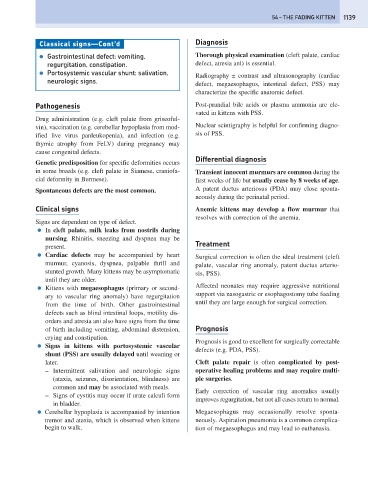Page 1147 - Problem-Based Feline Medicine
P. 1147
54 – THE FADING KITTEN 1139
Classical signs—Cont’d Diagnosis
● Gastrointestinal defect: vomiting, Thorough physical examination (cleft palate, cardiac
regurgitation, constipation. defect, atresia ani) is essential.
● Portosystemic vascular shunt: salivation,
Radiography ± contrast and ultrasonography (cardiac
neurologic signs.
defect, megaesophagus, intestinal defect, PSS) may
characterize the specific anatomic defect.
Pathogenesis Post-prandial bile acids or plasma ammonia are ele-
vated in kittens with PSS.
Drug administration (e.g. cleft palate from griseoful-
vin), vaccination (e.g. cerebellar hypoplasia from mod- Nuclear scintigraphy is helpful for confirming diagno-
ified live virus panleukopenia), and infection (e.g. sis of PSS.
thymic atrophy from FeLV) during pregnancy may
cause congenital defects.
Differential diagnosis
Genetic predisposition for specific deformities occurs
in some breeds (e.g. cleft palate in Siamese, craniofa- Transient innocent murmurs are common during the
cial deformity in Burmese). first weeks of life but usually cease by 8 weeks of age.
Spontaneous defects are the most common. A patent ductus arteriosus (PDA) may close sponta-
neously during the perinatal period.
Clinical signs Anemic kittens may develop a flow murmur that
resolves with correction of the anemia.
Signs are dependent on type of defect.
● In cleft palate, milk leaks from nostrils during
nursing. Rhinitis, sneezing and dyspnea may be
Treatment
present.
● Cardiac defects may be accompanied by heart Surgical correction is often the ideal treatment (cleft
murmur, cyanosis, dyspnea, palpable thrill and palate, vascular ring anomaly, patent ductus arterio-
stunted growth. Many kittens may be asymptomatic sis, PSS).
until they are older.
Affected neonates may require aggressive nutritional
● Kittens with megaesophagus (primary or second-
support via nasogastric or esophagostomy tube feeding
ary to vascular ring anomaly) have regurgitation
until they are large enough for surgical correction.
from the time of birth. Other gastrointestinal
defects such as blind intestinal loops, motility dis-
orders and atresia ani also have signs from the time
of birth including vomiting, abdominal distension, Prognosis
crying and constipation.
Prognosis is good to excellent for surgically correctable
● Signs in kittens with portosystemic vascular
defects (e.g. PDA, PSS).
shunt (PSS) are usually delayed until weaning or
later. Cleft palate repair is often complicated by post-
– Intermittent salivation and neurologic signs operative healing problems and may require multi-
(ataxia, seizures, disorientation, blindness) are ple surgeries.
common and may be associated with meals.
Early correction of vascular ring anomalies usually
– Signs of cystitis may occur if urate calculi form
improves regurgitation, but not all cases return to normal.
in bladder.
● Cerebellar hypoplasia is accompanied by intention Megaesophagus may occasionally resolve sponta-
tremor and ataxia, which is observed when kittens neously. Aspiration pneumonia is a common complica-
begin to walk. tion of megaesophagus and may lead to euthanasia.

